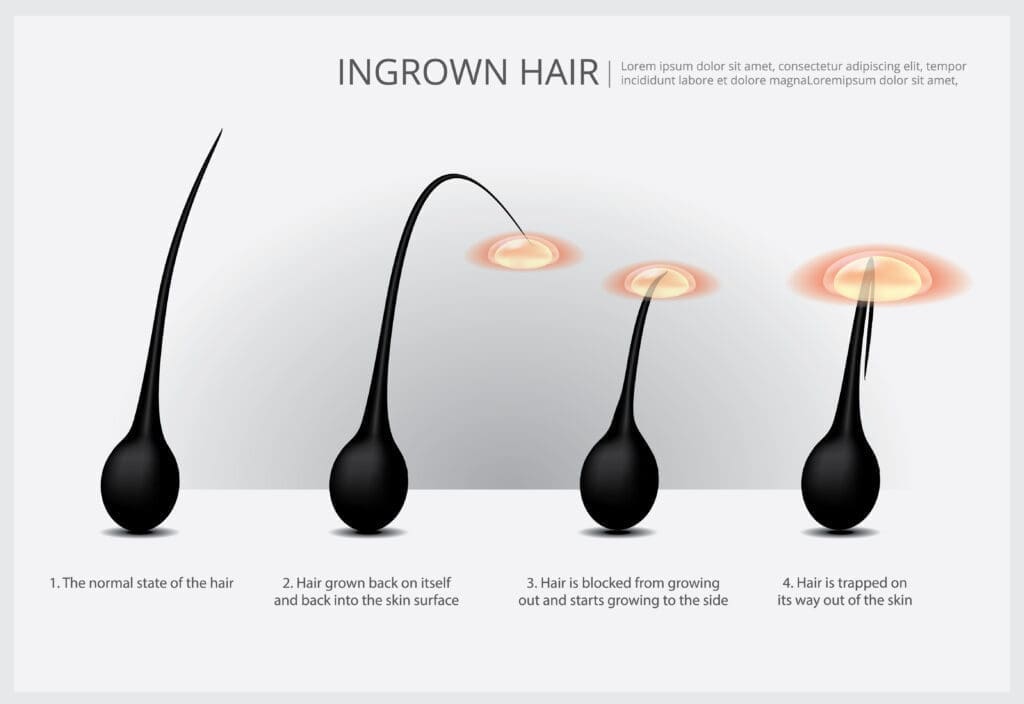Ingrown hair is painful and frustrating and can lead to infection and scarring. They are common when using hair removal methods such as shaving or waxing. This blog post will provide you with an overview of ingrown hairs and what causes them. We will also discuss the symptoms of malformed inches and offer natural remedies you can use at home to treat them. We’ve covered you, from using warm compresses to exfoliating with natural ingredients! Additionally, we will provide you with tips on how to prevent future occurrences of ingrown hairs. Keep reading to discover these effective natural remedies for malformed hair!
Understanding Ingrown Hairs
Deformed tress happens when curls grow back into the skin, causing inflammation and redness. Causes include shaving or waxing too closely, curly locks, and blocked follicles due to dead skin cells. They can occur on the scalp, pubic area, buttocks, and legs. Treatments include warm compresses, tea tree oil application, and exfoliation. For severe cases or if there are accompanying symptoms like a rash or scars, consult a dermatologist.
What is an Ingrown Hairs?
An ingrown hair occurs when the growth is sideways into the skin instead of growing straight out. It can lead to bumps, redness, and irritation. Deformed curls are typical in coarse or curly areas, like the beard area, armpits, and bikini line.
The Causes of Impacted Hairs
Malformed locks can happen for several reasons, like shaving too closely or using a dull razor. Waxing and clogged tress follicles from dead skin cells and oil are common causes.
Symptoms of Malformed Tresses
Symptoms of malformed curls may include a small, raised bump on the skin’s surface, redness, swelling, and itchiness. In a few cases, shapeless locks can become infected, leading to the presence of pus, pain, and a pimple-like bump. Identifying these symptoms is crucial in understanding and addressing this common dermatological concern.
Identifying a Pseudofolliculitis
Malformed hairs are visible by their location beneath the skin. Look for a bump with curls trapped inside or a visible hair follicle. These hairs often cause discomfort or a sharp, stinging sensation. When examining the affected area, watch for these signs to determine if you have a malformed mane.
Seek medical attention if a malformed tress becomes infected or doesn’t improve with home remedies. Signs of infection include increased redness, warmth, swelling, and pus or drainage. A dermatologist may recommend antibiotics or treatments for severe or recurring tress growth.
Natural Remedies for Folliculitis Treatment
A warm compress helps soothe the skin, reducing inflammation around impacted locks. With its antimicrobial properties, tea tree oil prevents infection and reduces swelling. Exfoliating the skin using natural ingredients like sugar or oatmeal removes dead skin cells to avoid deformed locks. Apply a warm or compressed cloth to the affected area to promote healing and alleviate discomfort. It will soften the skin, open pores, and help release impacted locks. Repeat multiple times daily for best results.
Tea Tree Oil Benefits
Tea tree oil’s anti-inflammatory properties reduce redness and swelling caused by malformed trees. Coconut or olive oils mix with carrier oils before applying to the affected area. Its antimicrobial properties also help prevent infection. Enhance your impacted curl treatment with this natural remedy.
Also read:- Best Natural Oils for Hair Growth: A Herbal Guide.
Exfoliation using Natural Serum gp
Exfoliating the skin eliminates dead skin cells that can block tress follicles’ growth and lead to malformed tress. You can create a gentle scrub by combining sugar or oatmeal with a moisturizing agent like honey or coconut oil. Massage the scrub on your skin clockwise to remove dead skin cells and promote healthy tress growth.
Ingrown Hair Treatment at Home
To treat impacted locks at home:
- Take precautions.
- Exfoliate regularly to prevent dead skin build-up.
- Gently lift out impacted locks with a sterile needle.
- Reduce inflammation and redness by applying soothing gel or lotion.
- Avoid tight clothing that can irritate the area. If symptoms worsen or persist, consult a dermatologist.
Avoid Razor Shave Irritation
To avoid irritation and malformed locks, follow these practices: shave in the direction of hair growth, use warm water and a sharp razor, apply moisturizing cream or gel before shaving to reduce friction, avoid harsh scrubs or exfoliators on the affected area, and keep the surrounding skin clean and dry.
When to Stop Self-Shaving Treatment
If the ingrown hair becomes infected or shows signs of a cyst, consult a dermatologist. Stop self-treatment if it causes severe pain or worsens the condition. Consider other options if home remedies don’t improve the symptoms after a few weeks. Consult a dermatologist if the ingrown hair is causing scarring or permanent damage. Seek medical attention for pus or an infected ingrown hair.
How to Prevent Irritation?
To prevent further irritation, avoid plucking or tweezing curls. Keep your skin moisturized for healthy growth. The N.H.S. advises against shaving to prevent ingrown hairs. Consider waxing or electrolysis as alternative removal methods. Exfoliate gently to remove dead skin cells. Wear loose-fit clothing to minimize friction and irritation on the skin.
Natural ways to prevent Bump ingrown hairs?
To naturally prevent ingrown hairs:
- Apply aloe vera gel for soothing and hydration.
- Exfoliate with glycolic or lactic acid to prevent clogged follicles. – Use chamomile or tea tree oil for their anti-inflammatory properties.
- Keep the skin clean and opt for natural removal methods.
- Regular exfoliation is crucial for treatment and prevention.
- Apply a warm compress to soften and release the ingrown hair.
- Soothe the skin using natural antiseptics like tea tree oil or aloe vera.
- Avoid tight clothing and shaving too closely to prevent future problems.
Potential risks of using natural remedies?
While natural remedies for ingrown hair are safe, it’s important to be aware of potential risks and side effects. For example, essential oils may cause skin irritation or allergic reactions. Research and understand any potential risks before using a natural remedy. If you experience adverse reactions, consult a healthcare professional.
Can Wax, gel, and lotion get rid of hair cyst acne?
To effectively get rid of ingrown hair, try exfoliating regularly to prevent it from getting trapped. Use a warm compress cloth to help bring the hair to the surface. It’s important to avoid shaving or waxing until the ingrown hair has healed. If necessary, gently remove the hair with sterile tweezers, taking care not to break the skin.
What does an ingrown hair look like?
An ingrown hair resembles a small, red bump on the skin. It may cause discomfort or itching and can potentially become infected. The hair might be visible beneath the skin or wholly trapped underneath. Ingrown hairs are frequently visible in shaved or waxed areas, such as the face, neck, bikini, and legs.
Conclusion
Try natural remedies at home to alleviate discomfort and improve the appearance of ingrown hairs. Use a warm compress to reduce inflammation. Tea tree oil can prevent infection due to its antibacterial properties. Exfoliating with sugar or coffee grounds helps release trapped hairs. Be cautious not to irritate the area further, and know when to stop treatment. To prevent future ingrown hairs, exfoliate gently, moisturize regularly, and use proper shaving techniques. If you found these remedies helpful, share this blog on social media to help others with ingrown hairs.



